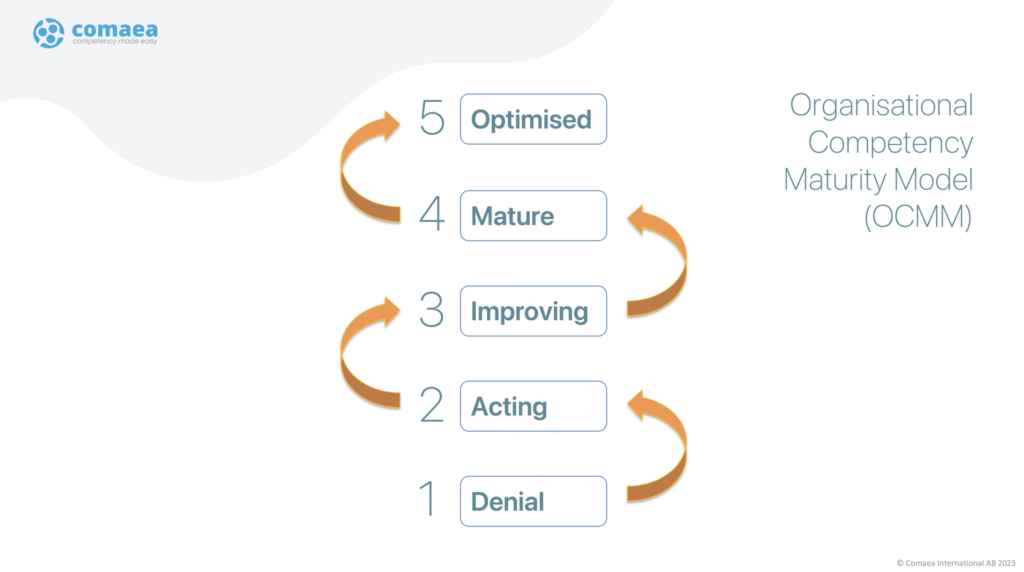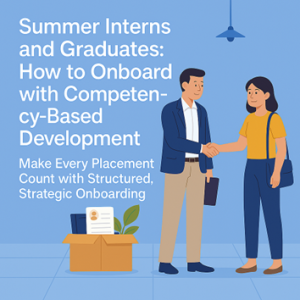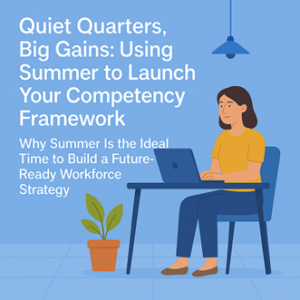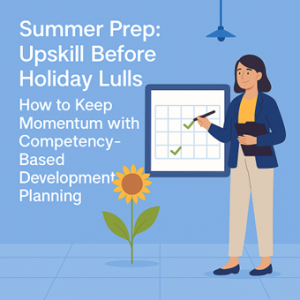
Whether you are starting out in your skills-led journey or have been doing it for years, the Organisational Competency Maturity Model (OCMM) helps you plan your steps in a structured and simple way.
What is the OCMM?
The Organisational Competency Maturity Model (OCMM) is a framework for assessing and benchmarking your organisation’s current position and for developing plans for improvement.
With the OCMM you can review your current approach to workforce management and understand the journey to embedding a competency-led approach.
Benefits
OCMM allows you to determine your organisation’s current state, including strengths and weaknesses, so you know which changes will deliver the most value.
OCMM will deliver the following benefits:
- Ensuring the organisation has the correct skills to deliver the vision and strategy
- Improved staff retention due to transparency of career development
- Assurance to internal and external clients of the capability of individuals and teams
- Visible commitment to staff development and improved succession planning
- Targeting development spend in proven areas of need
- Improved workforce agility enabling matching of skills to roles
Who is OCMM for?
OCMM benefits corporate, public sector, government, and non-profit organisations of all sizes and in a diverse range of industries.
Results of the assessment will support change initiatives at strategic and operational levels, and therefore will be of particular interest to:
- Directors
- Portfolio, programme, or project managers
- Heads of centres of excellence
- Bid managers or procurement leads
- Capability/performance improvement teams
- Auditing and assurance professionals.
How does OCMM work?
Comaea consultants and partners carry out an initial assessment and advise on the route to maturity or optimisation
The assessment can be scaled to suit the organisation and objectives, and provide important data to create a business case for implementing a competency-led approach to workforce management

Speech bubble
Competency Maturity levels
Level 1 – Denial
- No understanding or application of competency frameworks
- No desire to implement a competency based approach
Level 2 – Acting
- The organisation understands competencies are important for transparency and execution of strategy
- Ad-hoc competency self-assessments are carried out sporadically using forms or spreadsheets.
- Roles are not generally aligned to competencies
- Competencies do not regularly feature in development discussion
Level 3 – Improving
- Pockets of regular competency assessment happen in small areas of the organisation
- Structured competency frameworks are used to provide a self-assessment and occasional 180 review using forms or spreadsheets
- Some roles are mapped to competencies and provide opportunity to focus development on gaps.
- Some Career paths are mapped using competencies to provide clarity on development
Level 4 – Mature
- Regular competency assessments are carried out broadly across the organisation.
- Most roles are mapped to competencies
- Self-assessments are moderated and competency is part of development discussions
- A technology solution enables consolidation and aggregation of data
- Career pathways mapped to Competency frameworks provide transparency for development.
- Occasionally competency based interviews are used
- Cross-organisation skills have been identified and are used by some some families
Level 5 – Optimised
- Competency frameworks are an integral part working in the organisation and are linked to strategy
- Competencies are structured with a common taxonomy and regularly reviewed.
- A technology solution is implemented to provide detailed metrics and insights
- Skills are mapped to Roles and periodically updated to ensure their currency.
- Transferable skills (e.g. behaviours, leadership and cultural competencies) are used across all job families
- Employees and managers use skills assessment as part of regular development discussions.
- Competency frameworks are used for recruitment, succession planning and workforce agility and align with the strategy and vision of the organisation
Typical timelines
Your starting point on your skills-led journey will differ from others, but typically we see a 5 year programme to get from Level 1 – Denial to Level 5 – Optimised. This will be considerably shorter with the right level of sponsorship, desire and culture. The OCMM enables you you plot your journey with checkpoints and assure stakeholders of progress and return on investment.
What is the starting point in your organisation on the OCMM?

Typical Timelines for the OCMM
Find out more
If you want to know more about the OCMM , then please get in touch
or download the OCMM pdf.
About Comaea:
Comaea is the bit that your LMS and HR systems don’t do very well. It is a specialist competency management software tool that provides employees a clear competency development structure to help them plan their career, and provides organisations a comprehensive data analytics package that enables data-driven decisions. Our consultants have worked with structured competency profiling for over 30 years in a wide range of industries globally, and are able to advise, guide and support your skills-led journey.



